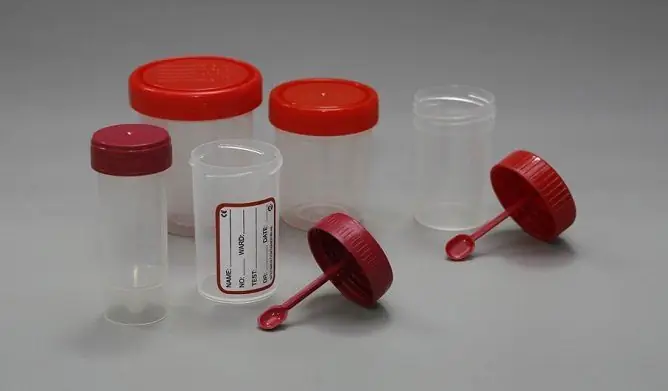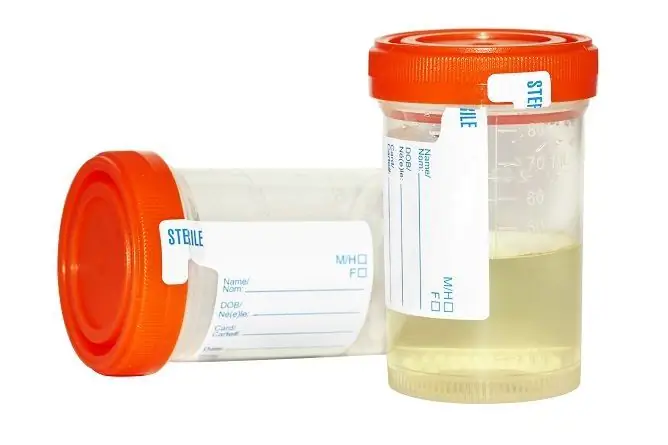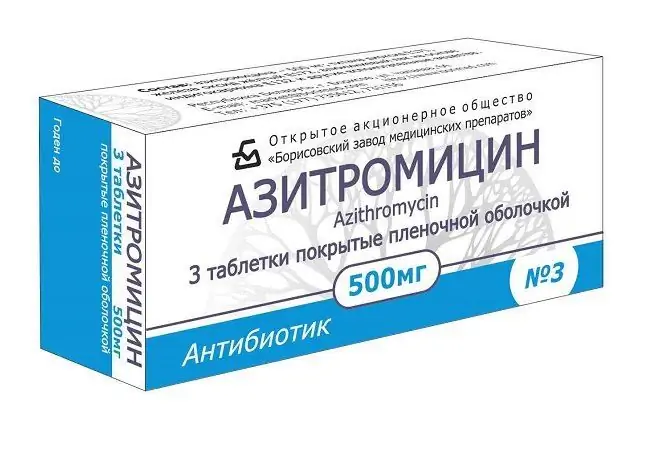- Author Rachel Wainwright [email protected].
- Public 2023-12-15 07:39.
- Last modified 2025-11-02 20:14.
How to take a stool test: the rules for collecting material from adults and children
The content of the article:
- How to collect feces for analysis correctly
-
Features of collecting material for other studies
- Fecal occult blood test
- Stool analysis for helminth eggs
- Bacteriological analysis of feces
- Feces collection for analysis in children
- Indicators determined in the analysis of feces
How to take a stool test, in what cases is it necessary, and are there any peculiarities of collecting material for different studies - questions that patients often ask the attending physician when receiving a referral.
Feces are the end product of digestion, the contents of the distal colon, released during bowel movements. Feces are formed during the passage of food components through the entire gastrointestinal tract, therefore, according to their condition and properties, one can judge the state of all parts of the digestive system.
Stool analysis is a study of the physical, chemical and microscopic characteristics of the composition of stool, the identification of pathological components or impurities in order to diagnose diseases of the digestive system or assess the effectiveness of the therapy. A general analysis of feces to determine the digestive capacity of the stomach and intestines is called a coprogram. The laboratory examines the physical properties of the sample: color, smell, quantity, shape, consistency, pH.
How to collect feces for analysis correctly
A general analysis of feces is prescribed as part of a comprehensive preventive examination, it gives a general picture of the state of health of the intestines and some other parts of the digestive system, allows you to diagnose inflammatory and other diseases of the gastrointestinal tract, dysbiosis. Stool analysis is necessary if intestinal malabsorption syndrome is suspected. With the help of a coprogram, the acid-forming, motor function of the stomach and duodenum, the enzymatic function of the gastrointestinal tract are examined, intestinal parasites are identified, and the nature and approximate localization of pathology are determined.

For analysis, feces should be collected after spontaneous bowel movements, an enema or laxative should not be used
Careful adherence to the rules of preparation and the technique of collecting material largely affects the reliability of the result of the coprogram.
It is recommended to empty the bladder before defecation, then thoroughly wash the external genitals. For hygiene procedures, it is better to use soap without foaming additives or fragrances. To prevent urine and water from entering the feces, carefully wipe off the moisture with a towel.
A container should be prepared in advance in which the fecal analysis will be delivered to the laboratory. This can be a sterile glass jar with a tight-fitting lid, but it is best to use a special plastic container for collecting stool with a spatula built into the lid (available at the pharmacy). In advance, you need to take care of the container from which the feces will be collected for analysis. It can be a dry and clean boat, or you can also attach plastic wrap to the surface of the toilet bowl. After defecation, 10-15 g of feces are taken with a spatula into the prepared dish. It is important not to forget to sign the container before submitting it to the laboratory.
Is it possible to collect material for analysis in the evening and send it to the laboratory in the morning? This option is acceptable, but it should be noted that it is recommended to deliver the biomaterial to the laboratory no later than 8 hours after its collection. In this case, it is recommended to store the container with the evening feces sample at home in the refrigerator, at a temperature of +3 to +5 ºС. You can't freeze yesterday's material. How long can the collected stool be stored in the refrigerator? Feces for general analysis can be left on the middle shelf of the refrigerator for 6-8 hours.
It is forbidden to collect material for research earlier than two days after the X-ray contrast study of the digestive tract (irrigoscopy, barium passage). For women during menstruation, it is better to refrain from submitting feces for research, but if the analysis cannot be postponed, a vaginal swab is used during bowel movements.
The stool intended for the test should be formed naturally, no enema or laxatives should be used. Three days before collection of feces, it is recommended to exclude drugs that affect peristalsis, composition and color of feces (sorbents, antibiotics, contrast agents, motility agents, rectal suppositories).
On the eve of taking a feces analysis, it is necessary to exclude from the diet foods that contribute to a change in the color of feces (tomatoes, beets, rhubarb), excessive gas formation in the intestines, diarrhea or constipation.
Features of collecting material for other studies
Fecal occult blood test
A week before taking a stool test, it is necessary to stop taking iron-containing drugs, ascorbic acid, nonsteroidal anti-inflammatory drugs and acetylsalicylic acid. Three days before the study, foods containing iron (meat, offal, white beans, bell peppers, apples, green onions, spinach) are excluded from the diet.
Stool analysis for helminth eggs
A week before the study, it is necessary to stop taking antiparasitic drugs, iron preparations, barium, bismuth, antidiarrheals and antacids, and limit the intake of fatty foods. Stool samples should be taken from different parts of the stool: central, upper and lateral. The minimum volume of a stool sample is about two teaspoons. A single test for worm eggs cannot always reveal parasites in feces, therefore it is recommended to pass several repeated tests with an interval of no more than 3-5 days. The study of feces on lamblia is carried out for a month every week.
When analyzing for opisthorchiasis, difficulties are encountered in diagnosing the early stage of the disease. For greater reliability of detection of helminth cysts, feces are recommended to be taken in larger quantities than in other studies.
The study for enterobiasis allows you to more accurately identify the presence or absence of pinworm eggs. To obtain reliable results, before collecting the material, you should not toilet the anus and empty the intestines. A plastic container with a long cotton swab is suitable for collecting material. With the tip of a cotton swab, you need to take a scraping from the perianal folds, carefully lower the stick into the container and close the lid tightly. To obtain the most accurate results, it is recommended to perform the analysis three times.
Bacteriological analysis of feces
Analysis of feces for the intestinal group allows you to determine the presence of causative agents of intestinal infection. Also, bacteriological examination allows you to determine the sensitivity of the identified infectious agent to antibacterial drugs. Three days before the study, it is necessary to stop taking antibiotics, iron preparations, laxatives, rectal suppositories. It is recommended to exclude meat dishes from the diet, do not take alcohol. The collection of material is carried out in a special sterile container (container). To exclude an error and get reliable results, feces should be donated three times.
Feces collection for analysis in children
To collect material from infants, a diaper or oilcloth is used. If the stool is liquid, it can be poured from a diaper or oilcloth into a jar. With constipation, to stimulate bowel movements in newborns, you can massage the abdomen; in some cases, a rectal gas outlet tube can help cope with the problem.
If the child already walks to the potty on his own, the same rules for collecting material are followed as in adults. Before collecting a stool sample, the pot should be cleaned without the use of disinfectants or cleaning agents.
Indicators determined in the analysis of feces
Normally, the feces have a cylindrical shape and a compact homogeneous consistency, the color of the feces can have various shades of brown, the water content in the feces is about 80%. The smell of feces in a healthy person is unpleasant, but not fetid. With a normal diet, the reaction of feces is neutral or slightly alkaline.

For bacteriological examination, feces should be collected in a sterile container.
Microscopic examination makes it possible to determine the presence of connective tissues, muscle fibers, neutral fats and acids, plant fiber and starch in the feces. With normal digestion, in the analysis of feces, connective tissue is absent, feces do not contain neutral fats and fatty acids, small amounts of muscle fibers may appear after eating meat. Digestible fiber is not normally found, the amount of indigestible plant fiber depends on the nature of the diet. There are no starch grains in the feces of a healthy person.
During the analysis, a sample of feces is checked for the presence of blood, mucus, pus, yeast, crystalline formations, and the presence of parasite eggs is determined.
Chemical research includes the detection of protein, bilirubin, blood corpuscles, stercobilin, it allows to reveal the amount of cellular suspension (erythrocytes, leukocytes and epithelial cells) in feces. Normally, in a healthy person, erythrocytes in the feces are absent, single leukocyte cells and a small number of squamous and columnar intestinal epithelium cells can be found.
YouTube video related to the article:

Anna Kozlova Medical journalist About the author
Education: Rostov State Medical University, specialty "General Medicine".
Found a mistake in the text? Select it and press Ctrl + Enter.






